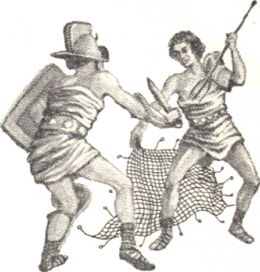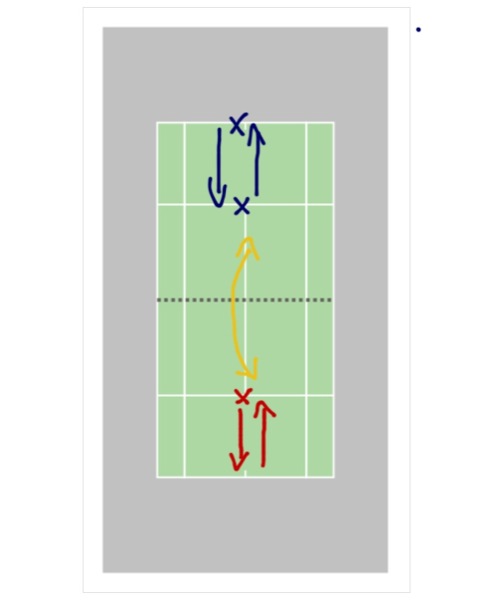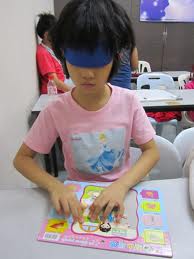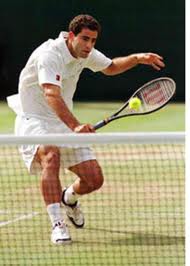We live in a highly industrialized world and it's foreseeable that at least a handful of times in your life you will show up just in time for your match or a little bit late (perhaps due to traffic or misdirection by your navigation system). Assuming that you didn't get defaulted, how ensure that you obtain the best possible warm-up under the circumstances? That is, the same, old routine might not do the trick particularly if you're playing against a tough opponent.
I have found that the best routine is one that gets the blood flowing the fastest and also "warms-up" (i.e., focuses) the eyes. First, chase down EVERY ball. If your opponent hits an errant shot, give chase even if the ball is way wide or deep. This is the time to bring out your inner tiger and the ball has blood on it. Don't let a single ball get by you. Second, when the opponent is at the net, warm up from INSIDE the baseline. This will force you to take FAST, SHORT steps and will also serve to trigger your eyes and how they see the ball. Again, NO BALL GETS BY YOU! Get in position and work the warm-up point like a boxer with high intensity. Third, take extra overheads to get some blood flowing to your back and shoulder muscles. This will help with your serves, particularly in the first couple of games. After finishing your net routine, PLAY ONE MORE warm-up rally from the baseline. In this rally, try to hit a lot of "inside-outs". That is, rather than being flat-footed in just hitting the ball back-and-forth to your opponent without rhyme or reason, focus on moving your feet, getting in positing and staying loose. Fourth, as you're warming up your serve, again, chase down every serve from your opponent and see if you can catch it on your racket. If the serve gets by you, don't walk to get the ball - RUN. INTENSITY is the key concept here. You have 5-6 minutes to get a decent warm-up so use every SECOND to getting your body to optimal competitive levels in every aspect. As you're starting to play the match, it's important to keep the intensity flowing for a few games before ratcheting back to more manageable levels. During these 2-3 games, (1) MAKE EVERY FIRST SERVE, (2) MAKE NO UNFORCED ERRORS, and (3) IF POSSIBLE, HIT NO WINNERS. Work hard for every point and establish a pattern for doing battle the rest of the match.
Unfortunately, a lot of players show up late for the match and do the same thing as they have done for previous matches - where they may have had the opportunity to warm up. Unless you're special, this is a misguided approach to big matches. The warm-up is not just for the strokes but, as the name entails, it serves the body as well. If you're starting the match cold (which is something that happens to unexperienced juniors all too often), chances are that you will lose the first few games. In big matches, this may be sufficient to lose the set. Lose the set, and now you have an uphill battles both score-wise and confidence-wise.
Thus, if you CARE about the outcome of the match, enter the arena with the attitude of a warrior - for those first 5-6 minutes, it's not a tennis match, it's a gladiatorial contest.

Note, however, that this should not be used as an alternative to proper warm-up. This is an emergency routine for those handful of times when you're unable to follow your prescribed regimen.
 Monday, May 7, 2012 at 09:26AM
Monday, May 7, 2012 at 09:26AM  CAtennis
CAtennis  Are you the type of player who jumps straight into baseline-to-baseline rallies only to find yourself searching for rhythm and feel 15 minutes into the workout? If so, look to warm up your arms, feet and eyes by first rallying up-close with your practice partner (i.e., service line to service line). You will see and feel the ball gradually and then you can back up to the baseline. However, before jumping straight into a baseline slugfest, see if you can master this following warm-up drill (we call it "The Russian Warm Drill" because it has been brought to our attention by Ms. Elena Bovina).
Are you the type of player who jumps straight into baseline-to-baseline rallies only to find yourself searching for rhythm and feel 15 minutes into the workout? If so, look to warm up your arms, feet and eyes by first rallying up-close with your practice partner (i.e., service line to service line). You will see and feel the ball gradually and then you can back up to the baseline. However, before jumping straight into a baseline slugfest, see if you can master this following warm-up drill (we call it "The Russian Warm Drill" because it has been brought to our attention by Ms. Elena Bovina). 




